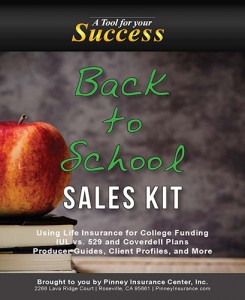
This August, we’re focused on helping clients use life insurance to pay for their children’s college education.
It’s time to go back to school, but this time, we’re learning about tax-advantaged savings methods instead of geometry. Why? Because knowing how to calculate the inscribed angle of a circle isn’t going to help your clients secure their retirement…or afford the steadily rising costs of a college education.
The Challenge: Rising Tuition Rates
$31,231: average tuition for private college, 2014–2015 school year
Over the past 35 years, tuition at public colleges and universities has almost quadrupled. That’s according to the New York Times, which cites an average cost of $9,139 per year in 2014. Ouch. The Times also notes that if new car prices skyrocketed like this, the average new vehicle would set you back $80,000. Double ouch.
What’s worse is that nothing appears to be changing.
In fact, according to FinAid.org, college costs are expected to continue rising about 8% annually. For comparison's sake, over the last decade, inflation has hovered around the 2.5% mark, according to The American College. Trying to save for something that's almost quadrupling the inflation rate is a big challenge. It's an even bigger challenge if your client’s kids are in, say, middle school – can you image how much college might cost by the time they’re ready to go?
Those are the facts. We can’t change them, but we can help our clients do something about them.
That’s why cash value life insurance is a great vehicle to help your clients achieve several financial goals at once, including shouldering some or all of the cost of a college education for the kids.
The Solution: Cash Value Life Insurance
Cash value life insurance works well as a college-savings vehicle for a few reasons:
- It can offer a guaranteed rate of return. Our partner, MTL, offers the Smart Money Solution that offers a 4% guaranteed rate of growth on your client's cash value (the interest earned is offset by expense and mortality charges). Some participating policies also offer a non-guaranteed dividend that pays even more into your client's policy - all tax-deferred.
- It can offer immediate liquidity and access to cash value. That cash value can be accessed through tax-free loans up to the value of your client's total premium paid. The longer they've had the policy, the bigger the loan they can take out to pay for a child's tuition.
Parents who make less than $100,000/year are more likely to worry about paying for kids' college (77%) than paying for retirement (73%).
- Cash value is NOT considered an asset when applying for federal student aid using the FAFSA form. Other retirement savings vehicles, such as 401(k) or IRA accounts, are counted as family assets when applying for federal student aid. Reallocating assets from CDs or stocks into a whole life insurance policy may reduce the amount a family is expected to contribute to a child's education, according to the calculations used by the government when they look at your client's FAFSA form. This can also open the door to qualify your client's children for more scholarships and grants. Score.
- It provides the guaranteed death benefit protection your client needs. In the rush to save for retirement and pay for college, sometimes clients overlook a more basic financial need. A life insurance death benefit can be used to pay for college - and the rest of the family's expenses, too - if your client passes away. It's what life insurance was designed to do, and no 401(k) can offer this particular benefit.
- It doesn't put your client's retirement savings at a disadvantage. Part of the problem with saving for a child's college tuition is that it keeps parents from socking money away for their retirement. Cash value life insurance doesn't pose the same problem. Cash from policy loans or withdrawals can be used for anything at any time. Putting money into a cash value policy isn't the same as contributing to a 401(k) that's untouchable (without heavy penalties) until age 65 1/2. Your client can access the cash to pay for a semester of tuition, a new computer for their child, or if the child chooses not to go to college, it's available for supplemental retirement income.
This back-to-school season, make time to go through your book of business. Which of your clients has kids in elementary school, middle school, or even early high school? It's never too early - or too late - to start a college fund using cash value life insurance.

